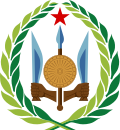Origin
Harar which had held the position of the capital for 58 years between 1519 and 1576, was too exposed to the frequent Oromo attacks and as a result, lost its strategic importance. Consequently, the new Imamate decided to relocate its capital to Aussa, which was more defensible and provided a more secure location to govern from. This decision was made in light of the challenging circumstances that the Imamate was facing and the need for a capital that could withstand external threats. As a result, Aussa became the new seat of power and played a critical role in the history and development of the Imamate. [2] After the transfer of the government seat to Aussa by Imam Muhammad Gasa., [3] [4] from the month of Jumad al-Akhirah of the year 1576 onwards, the region came under the rule of a representative of the Imam of Aussa. This marked a significant change in the political structure of the region and the beginning of a new era of governance. [5] [6] [7]
Aussa in the late 16th century Arabic text of Harar "Taʾrīkh al-mulūk" was stated to be occupied by the Adalite holding the title Hegano and had already become a breeding ground for those opposing the rulers of the Harar-based Adal Sultanate. [8] Several historians state the imamate was of Harari origin. [9] [10] [11] [12]
Internal conflict
This polity was marred with internal conflicts between the Harla and the imams. [13] The Dardöra (Darod) imams who had established themselves in Aussa alongside the Harla already established in the region was then followed by other allies and supporters of Imam Muhammad Gasa in 1585. Their arrival in the region created tension with the Dardōra and with the Harla already established in the region. [14] The Harla who had already established themselves in Aussa came into conflict with the nomadic Afars who surrounded Aussa. An Arabic chronicle reports that only 8 years after the transfer of the capital to Aussa, they began to raid one of the major caravan routes. This led to fierce fighting in which 10 noblemen were killed. [15] [16]
The established Dardöra (Darod) were in permanent disunity, while the sedentary Awsimára were torn between allegiance and resistance. Around 1628–1636, Ahmad Yäwwi, chief of the Harla, restructured the land system by tracing the boundaries of the fields. [17] This led to tensions between the imams and the sedentary locals, including the Harla, who became the landowners (known as baddá-h abbá). However, the stages that led to the expansion of the Debné and We'ima to the west and south of the oasis, as well as the Mödaytó to the north, remain not completely known. It is believed that this expansion was favored by the Harla, who were in search of external support in their struggle against the imams.
With the help of the Mudaito, the Harla burnt the residence of Imam Salmän in Handág, which is believed to be located in Wablé Fánta, at the confluence of the Nangaltá and Afal-Gedé. The imam died in 1750, and Salmän is reputed to be the last imam of Gara. His successor was the ancestor of the Dúrussó fraction, Mahammad "Düs" (around 1750–1760), who became the first Harla "Sultan" of Awsa and was referred to as "Rais" in Arab chronicles. [18] [19] [20] [21] According to Heloise Mercier, the inhabitants of Harar who had migrated to Aussa were unable to maintain their customs and dialect contrary to those who lingered in Harar. [22] In the 17th century the induction of upland populations of Harla and Doba into Afar identity would lead to the emergence of the Aussa Sultanate. [23]
This page is based on this
Wikipedia article Text is available under the
CC BY-SA 4.0 license; additional terms may apply.
Images, videos and audio are available under their respective licenses.


